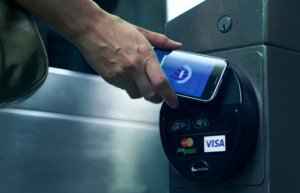Share This
Related Posts
Tags
Near-Field Communications
By Erica Rascón on May 30, 2013 in Technology
 Increase your property’s visibility to perspective clients while promoting tenant engagement through advances in near-field communication.
Increase your property’s visibility to perspective clients while promoting tenant engagement through advances in near-field communication.
You may recall advertisements for various smartphones where file and photo sharing occur by simply bringing the devices within a few centimeters of each other. You may have also seen SmartPass devices in stores and vending machines that allow customers to pay for products and services by passing their credit card over a tag. Such technologies are examples of near-field communication (NFC), a rapidly growing series of standards that allow mobile devices to communicate with other devices within close proximity.
NFC has taken hold in various pockets of commerce and entertainment, making transactions faster and more convenient. Ticketing for transportation and entertainment venues around the globe utilize cards and key fobs to permit access goods and services. Box offices allow patrons to present digital tickets in place of their paper counterparts. Loyalty programs for various stores rely on stickers and cards to connect customers to rewards and discounts. Perhaps most importantly, many of us have offered silent expressions of gratitude as our children quietly enjoy multi-player gaming on separate devices while sitting in the back seat of the car. It sure beats arguing over the radio station.
The versatility of NFC has proven to be its greatest asset. NFC standards permit a nearly effortless exchange of images, videos, data and text. It can replace paper while still leaving a trail suitable for verification and authenticity. As the market continues to grow, the potential of NFC will continue to expand. Near-field communication lends itself to practical and fun uses within the multifamily housing industry:
– Leasing agents can create and instantly share marketing cards that include contact information, property details, property photos, video and more. (Yardi PopCard is a great example of such functionality.) Such digital marketing and communication allows offices to save money on print resources while protecting the environment.
– Perspective tenants and leasing agents can complete the application process faster by transferring files and verifying data more quickly, with fewer documents to exchange.
– Staff and tenants alike may rest assured that office operations are more secure by minimizing access to sensitive paperwork stored in the leasing office.
– Tenants may enjoy instant, paperless bill pay.
– By accessing a central location such as the leasing office or community center, residents are privy to NFC tags that host events calendars, coupons for local shops and other perks.
– The community can provide keyless entry through security gates for staff and residents. The technology can also be used to and gain access to game rooms, the community pool, fitness center, and community events.
With much potential comes significant threats. As with all technology, NFC is susceptible to outside interference. Picking up the RF signal for data transfers by using an antenna, also known as eavesdropping, poses a threat to NFC integrity. Eavesdropping is a less common violation than data modification, in which intruders use an RFID jammer to alter or destroy data. Relay attacks are perhaps the most common (or are at least the easiest) in that the breach can be accomplished using two NFC-enabled devices; the intruder poses as the owner of another smart card to intercept data. Such offenses are not committed on a large scale by any means but they are viable threats, worthy of consideration. As the NFC technology develops, these weak points will be addressed and the subsequent threats minimized. Property managers should ensure that staff is education on the benefits, risks, and maintenance required of NFC usage.
What additional uses of near-field technology may be beneficial to the multifamily housing industry?
